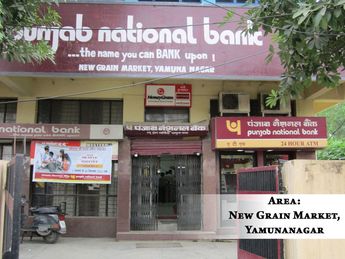
BANK ACCOUNTS
Chose a right bank account that suits you .
Basic requirement to do a financial transaction in India is to have a bank account . There are several types of savings bank accounts available in India, each catering to different needs and offering varying benefits. Here are some of the common types:
Basic Savings Account:
Most basic and widely available type of savings account. No minimum balance requirement. Limited number of transactions per month.
Ideal for those with low income or infrequent banking needs.
Regular Savings Account:
Requires a minimum balance to be maintained.
Offers more features and benefits than a basic savings account, such as unlimited transactions, chequebook facility, and higher interest rates.
Suitable for individuals with moderate banking needs.
Further special types of bank accounts are available to suit the individual needs Some such types of accounts are are
1. Salary Savings Account: Specifically designed for salaried individuals. Often offered by banks in collaboration with employers.
May have lower or no minimum balance requirements. Provides additional benefits like personal loans, credit cards, and insurance products.
2. Women’s Savings Account: Tailored to meet the specific needs of women. May offer higher interest rates, preferential treatment, and additional benefits like insurance coverage or discounts on products and services.
3. Senior Citizen Savings Account: Designed for individuals aged 60 and above. Offers higher interest rates than regular savings accounts.
May have lower or no minimum balance requirements. Provides additional benefits like doorstep banking services and preferential treatment.
4. NRI Savings Account: Specifically for Non-Resident Indians (NRIs). Allows NRIs to maintain a savings account in India even while residing abroad. Offers features like repatriation of funds, tax benefits, and online banking facilities.
5. Joint Savings Account: Can be opened by two or more individuals. Both account holders have equal rights to operate the account.
Suitable for couples, families, or business partners.
6. Minor’s Savings Account: Can be opened in the name of a minor (below 18 years of age). Operated by a guardian on behalf of the minor. Helps inculcate savings habits in children.
7. Digital Savings Account: Can be opened entirely online without visiting a bank branch. Offers features like mobile banking, online transfers, and paperless statements. Suitable for tech-savvy individuals who prefer digital banking.
8. Savings Plus Account: Combines a savings account with a fixed deposit or recurring deposit. Offers higher interest rates than regular savings accounts. Provides flexibility to withdraw funds from the savings component while the fixed or recurring deposit continues to earn interest.
These are just some of the types of savings bank accounts available in India. The specific features, benefits, and requirements may vary from bank to bank. It is advisable to compare different options and choose an account that best suits your individual needs and preferences.
Sources and related content : Websites of various banks
What Documents are needed normally to open an account with a bank ?
The specific documents required to open a bank account in India can vary depending on the type of account, the bank, and your individual circumstances. However, some common documents that may be required include:
1. As Proof of Identity (POI):
- Aadhaar card
- Passport
- Voter ID card
- Driving license
- PAN card
- Employee ID card
- Ration card
2. As Proof of Address (POA):
- Aadhaar card
- Passport
- Voter ID card
- Driving license
- Electricity bill
- Telephone bill
- Rent agreement
3. Passport-sized photographs
Other Documents:
PAN card (mandatory for all individuals)
Income proof (may be required for certain types of accounts)
Introduction letter from a known account holder (may be required for certain banks or individuals)
Passport-sized photographs
It is important to note that these are just examples, and the actual documents required may vary. It is always best to check with the specific bank you are interested in to find out the exact requirements.
Additionally, if you are opening a joint account, you will need to provide identification and address proof for all account holders. If you are opening an account for a minor, you will need to provide identification and address proof for the guardian.
RULES FOR BASIC SAVINGS BANK DEPOSIT ACCOUNTS ( BSBD )
DATED 11.06 .2019 : Reserve Bank of India has issued new guidelines to banks on 10.06.2019 with regard to opening of Basic Savings Bank Deposit Accounts ( BSBD ) . As per the new notification , banks have to offer following free services without requirement of any minimum balances for their BSBD account holders .
1. The deposit of cash at bank branch as well as ATMs/CDMs
2.Receipt/ credit of money through any electronic channel or by means of deposit /collection of cheques drawn by Central/State Government agencies and departments
3. No limit on number and value of deposits that can be made in a month
4.Minimum of four withdrawals in a month, including ATM withdrawals
5. ATM Card or ATM-cum-Debit Card
Further banks have to make the BSBD account service available to all . However banks may charge service fee if any additional service , like issue of cheque book , is provided to the BSBD a/c holders at their request .
The holders of BSBD Account will not be eligible for opening any other savings bank deposit account in that bank. If a customer has any other existing savings bank deposit account in that bank, he/she will be required to close it within 30 days from the date of opening a BSBD Account. Further, before opening a BSBD account, a bank should take a declaration from the customer that he/she is not having a BSBD account in any other bank.
For RBI Notification dated 10.06.2019 , CLICK HERE
LATEST GUIDELINES ON KYC FOR OPENING ACCOUNTS WITH BANKS
DATED 10.01.2020 : Reserve Bank of India has amended Master Direction for KYC , vide their notification dated 09.01.2020 and advised bankers to obtain live pictures of customers for completing the E-KYC process . The notification has identified Digital KYC process as ” capturing live photo of the customer and officially valid document or the proof of possession of Aadhaar, where offline verification cannot be carried out, along with the latitude and longitude of the location where such live photo is being taken by an authorised officer of the bank ”
Further bankers can do video based customer identification process ( V-CIP ) for KYC verification . However all accounts opened through V-CIP shall be made operational only after being subject to concurrent audit, to ensure the integrity of process.
Bankers have to ensure that the process is a seamless, real-time, secured, end-to-end encrypted audiovisual interaction with the customer and the quality of the communication is adequate to allow identification of the customer beyond doubt. Bankers shall carry out the liveliness check in order to guard against spoofing and such other fraudulent manipulations. Banks can use either OTP based Aadhaar e-KYC authentication or Offline Verification of Aadhaar for identification. Further, services of Business Correspondents (BCs) may be used by banks for aiding the V-CIP.
Bankers shall ensure that photograph of the customer in the Aadhaar/PAN details matches with the customer undertaking the V-CIP and the identification details in Aadhaar/PAN shall match with the details provided by the customer.
As per the notification , customers have to furnish copy of any of the OVD document containing address and identity proofs along with recent photograph .
“Officially Valid Document” (OVD) will mean
a. the Aadhaar number where he is desirous of receiving any benefit or subsidy under any scheme notified under section 7 of the Aadhaar (Targeted Delivery of Financial and Other subsidies, Benefits and Services) Act, 2016 (18 of 2016); or he decides to submit his Aadhaar number voluntarily to a banking company or any reporting entity notified under first proviso to sub-section (1) of section 11A of the PML Act; or
b. the proof of possession of Aadhaar number where offline verification can be carried out; or
c. the proof of possession of Aadhaar number where offline verification cannot be carried out or
d. any Officially Valid Document (OVD) or the equivalent e-document thereof containing the details of his identity and address; and
such other documents including in respect of the nature of business and financial status of the client, or the equivalent e-documents thereof as may be required by the banker.
1. Passport,2. Driving licence
3.Proof of possession of Aadhaar number4. Voter’s Identity Card issued by the Election Commission of India
5. Job card issued by NREGA duly signed by an officer of the State Government and letter issued by theNational Population Register containing details of name and address.
Provided that,a. where the customer submits his proof of possession of Aadhaar number as an OVD, he may submit it in such form as are issued by the Unique Identification Authority of India.
b. where the OVD furnished by the customer does not have updated address, the following documents shall be deemed to be OVDs for the limited purpose of proof of address:-i. utility bill which is not more than two months old of any service provider (electricity, telephone, post-paid mobile phone, piped gas, water bill);
ii. property or Municipal tax receipt;iii. pension or family pension payment orders (PPOs) issued to retired employees by Government Departments or Public Sector
Undertakings, if they contain the address;iv. letter of allotment of accommodation from employer issued by State Government or Central Government Departments, statutory or regulatory bodies, public sector undertakings, scheduled commercial banks, financial institutions and listed companies and leave and licence agreements with such employers allotting official accommodation;
f. the Permanent Account Number or the equivalent e-document thereof or Form No. 60 as defined in Income-tax Rules, 1962
.Where a customer has provided his Aadhaar number as above for identification and wants to provide a current address, different from the address as per the identity information available in the Central Identities Data Repository, he may give a self-declaration to that effect to the Banker .
Where customer has provided PAN card , Banker shall capture a clear image of PAN card to be displayed by the customer during the process, except in cases where e-PAN is provided by the customer. The PAN details shall be verified from the database of the issuing authority
As the notification contains various amendments to the KYC process , one may know all the amendments carried out by RBI through Notification dated 09.01.2020 , by CLICKNIG HERE
BANK ACCOUNT OPENING MADE SIMPLE
DATED 31.05.2019 : If you are an Aadhaar card holder and if you are willing for bio-metric verification of your Aadhaar number , you need not submit any other document including your photograph for opening an account with a bank . However you may have to submit a copy of your PAN CARD or Form 60 along with your application .
Reserve Bank of India has amended Master Direction for KYC , vide their notification dated 29.05.2019 and the procedure for opening account is made simple . Even if you do not want to share your Aadhaar number with your bank , you may submit any one of the following OVD ( Officially Valid Document ) which contain address proof along with your recent photograph and copy of PAN CARD / FORM 60 .
1. Passport,
2. Driving licence 3. Voter’s Identity Card issued by the Election Commission of India
4. Job card issued by NREGA duly signed by an officer of the State Government and letter issued by theNational Population Register containing details of name and address.
In case your OVD does not contain your address proof , you may submit any of the following along with the OVD .
i. utility bill which is not more than two months old of any service provider (electricity, telephone, post-paid mobile phone, piped gas, water bill);
ii. property or Municipal tax receipt;iii. pension or family pension payment orders (PPOs) issued to retired employees by Government Departments or Public Sector
Undertakings, if they contain the address;iv. letter of allotment of accommodation from employer issued by State Government or Central Government Departments, statutory or regulatory bodies, public sector undertakings, scheduled commercial banks, financial institutions and listed companies and leave and licence agreements with such employers allotting official accommodation;
DISCLAIMER
Use of the information at this site www.plannprogress.com is at one’s own risk. We do not offer to sell or solicit to buy any financial instruments including Deposits , Loans whether short term or otherwise , Mortgages , Stocks , Insurance or Mutual Funds .This site does not offer to sell or solicitation to buy any securities and we will not be liable for any losses incurred or investment(s) made or decisions taken/or not taken based on the information provided herein. Information contained herein are purely for educational purposes and does not constitute a personal recommendation or take into account the particular investment objectives, financial situations, or needs of individual investors. Before acting on any recommendation, investors should consider whether it is suitable for their particular circumstances and, if necessary, seek an independent professional advice.
Entry to this site is free of charge and we do not charge any fees what so ever . No need for registration for viewing the site . All content and information is provided on an ‘As Is’ basis by us. Information herein is believed to be reliable, but does not warrant its completeness or accuracy and expressly disclaims all warranties and conditions of any kind, whether express or implied. As a condition to accessing http://www.plannprogress.com content and website, you agree to our Terms and Conditions of Use, Privacy policy & Disclaimer available on the links . The performance data quoted represents past performance and does not guarantee future results.
Articles/ Pages in this site contain advertisements and links to various third party sites / blogs as we have found articles therein interesting and useful and we believe reliable . Those links sites and advertisements may contain offer of sales or services of various kinds including financial services . We accept no responsibility for the accuracy , correctness and/or completeness of any information contained therein as we have not independently verified. The links and third party advertisements are governed by the privacy policy of those third party sites / blogs. We do not warrant or guarantee for any services or sales utilized therein . This site expressly disclaims all warranties and conditions of any kind, whether express or implied. However readers are advised to exercise their discretion in utilising / following any advice contained therein or utilizing any services or accepting their sales or any other offers and we do not take any responsibility what so ever.
The site is governed by Indian Laws and comes within the jurisdiction of courts in Mysuru , Karnataka , India
Contact Information : The site www.plannprogress.com is owned and operated by Mr . Manjunathan B.N. , No 37, 5thBlock , Madhuvana Layout , Sriramapura 2nd stage , Mysuru 570023 , Karnataka , India and can be contacted at email : info@plannprogress.com
This website uses cookies to provide necessary site functionality and to improve your experience. By using this website, you agree to our use of cookies.



